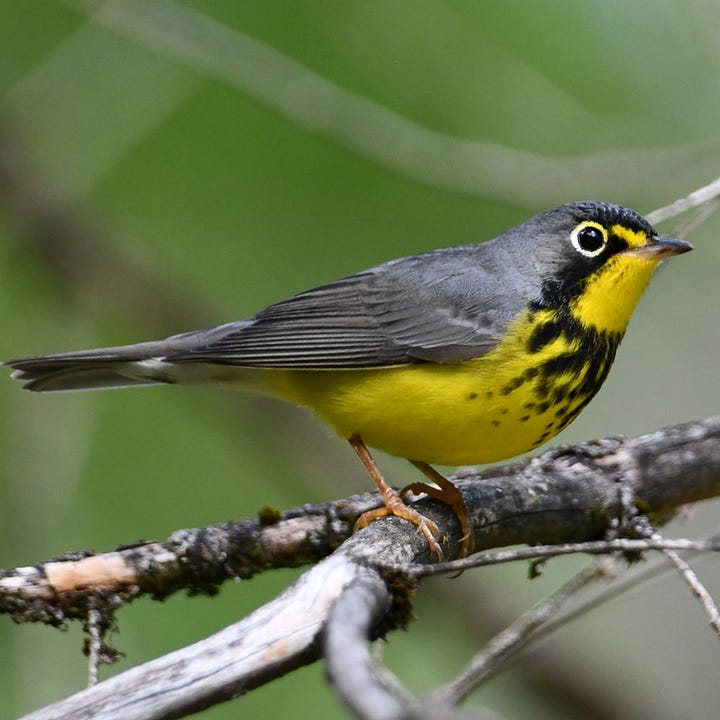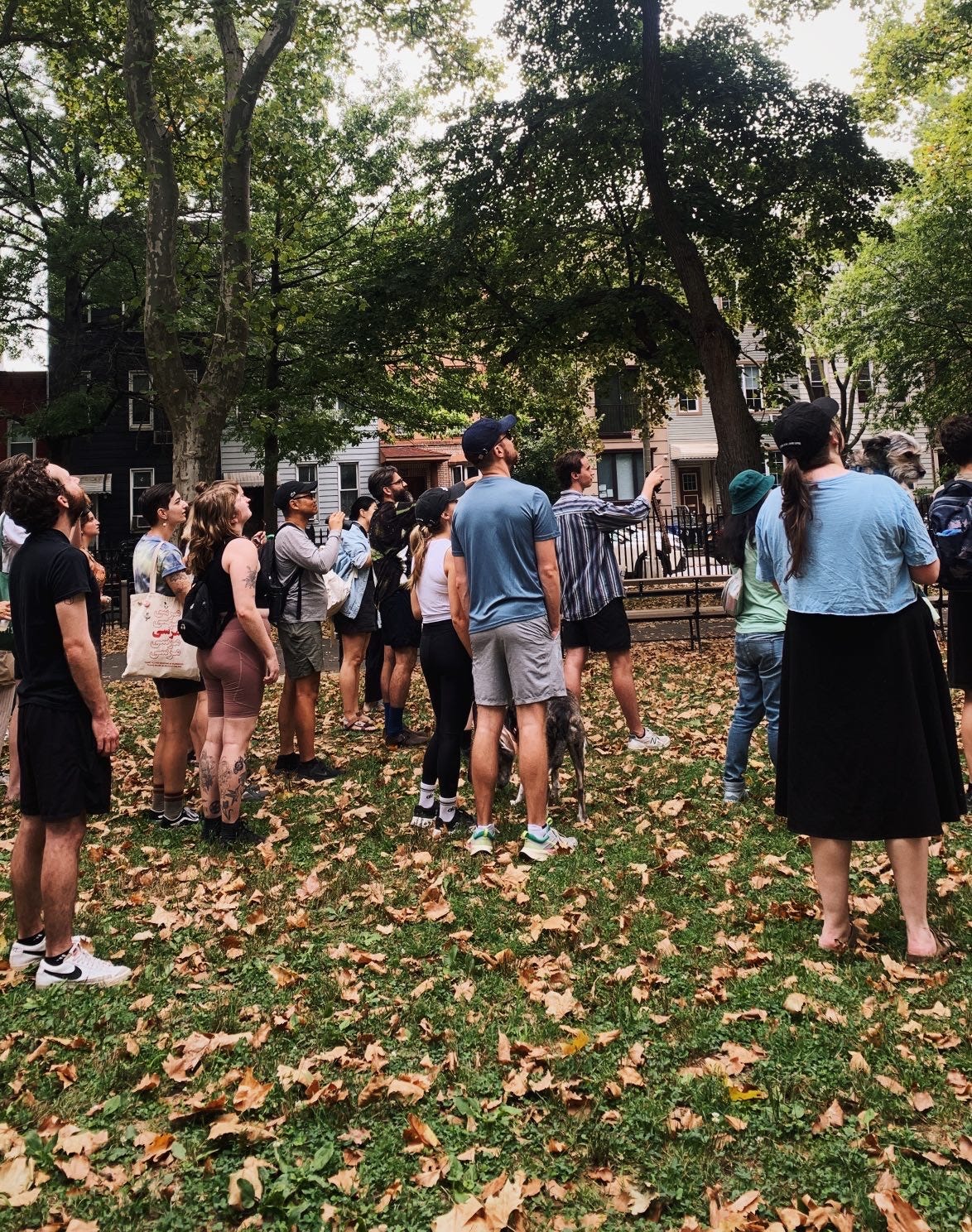Earthlings of NYC,
REMARK your calendars for Saturday, August 3rd, ~8:30PM. McGolrick Bird Club, in collaboration with NYC Bird Alliance field biologist, Nic Comparato, bring you …
BAT SUMMER.
What is BAT SUMMER? Slime green fit, pack of cigs, Bic lighter, strappy white top? Sure. A celebration of mammals who “want to be cute when they like and disgusting when they like … and are a bit exhausted having everything they do, say, wear, or feel being judged by some outside body?” Definitely.
It’ll all go down in Prospect Park. Details to come here and on Instagram.
Little Browns, Big Browns, Hoaries and Eastern Reds—several bat species can be found in New York City this time of year
SHORTY-SEASON JULY 15—JULY 21
"We have a cultural language for time. We have a seven-day week and we have minutes and hours, and those feel very real, because they have to, because we're compelled to live by them. But just think about your own lived experience, or how time feels to you, or observe a tree in your local park. The tree doesn't know what “November” is. These things push against what is an otherwise very much accepted concept of time." ― Jenny Odell, Saving Time: Discovering a Life Beyond the Clock
Current Japanese micro-season: Hawks learn to fly (!🤘😭). As for McGolrick Park, perhaps New York City and even larger swathes of the eastern US, we notice—
Dragonflies peak • Great blue lobelia blooms • Rattlesnake master flowers • Joe-Pye weeds blossom • Sycamore Tussock Moth caterpillars appear
Rattlesnake master is a perennial flowering plant, not a metal band. The Mesquakies used it in their ceremonial rattlesnake dance and to treat rattlesnake bites. Other Native Americans wove its fibrous leaves into sandals and baskets [source]
Joe Pye was the nickname of Joseph Shauquethqueat, a Mohican chief who lived in Massachusetts and New York in the 18th and early 19th centuries [source]
Shoutout National Moth Week! Held annually worldwide during the last full week of July. Celebrates the beauty, life cycles, and habitats of moths around the world. Learn more about Sycamore Tussies/Tigers here
We’ll declare this micro-season’s “official” name at year’s end. Stay tuned (to nature).
JULY 20, 2024 — SATURDAY
Conditions: Bright Gray • Attendance: 70-ish • Vibrations: Caffeinated
Saturday birds: Blue Jay · Chimney Swift · Common Grackle · Laughing Gull (flyover) · Downy Woodpecker (2) · Northern Cardinal… And our 5 urban park besties: Rock Pigeon · European Starling · American Robin · House Sparrow · Mourning Dove
Pic o’ the day via … author lost in our notifications—DM us for credit, anonymous hottie <3:
CONFESSION + SHORTY-LESSON: FALL WARBLERS
Confession
Devotees will recall our pre-spring warbler lessons. Done in the hopes of familiarizing new birders with the tiny, improbably beautiful, migrating songbirds who light up NYC’s parks in spring and fall, we made promises such as— there are only, like, 25 to must-know! EASY-PEASY!
Ay, here's the rub. We oversimplified in order to motivate. You warbler geniuses are, if you’ll permit an American football metaphor, at the 50 yard line—not stanky-legging in the end zone. That’s because most warbler species wear 2 plumages, breeding and non-, and we only learned half of them: the flashy outfits males model when seeking summer love.
The remaining half? Fall’s post-pairing plumages. Breeding males shed their fancy summer feathers for fits that have them looking indistinguishable from warbler females and juvenile males. These fall lüks are what we’ll primarily notice when migrating birds pass back through NYC en route to southern wintering grounds, come late August.
So, in summary: even though 25 warbler species have historically passed through McGolrick, there are 50 birds to learn.
Gasp. Sigh. Nervous fart.
The good news is that MOST of these alternate plumages match the patterns we previously learned, just with subdued colors—as if pressed by a tired printer. (A few are the same pattern with different colors. An even smaller handful are completely different. Don’t trip: we’ll cover them all.)
Let’s start with three species who land in that first category: the sleepy Gutenbergs. These three because they are similar looking enough to be confusable.


Devotees may recall breeding Canada males’ chunky necklaces and cute spectacles. In fall, those accessories are only faintly viewable. See photo right.


Spring’s Nashvilles are all eye-rings and gray cheeks over yellow throats/bottoms, olive-yellow wings. In fall, the eye-rings remain bright—the rest washes out.
Notice how, unlike the fall Canada, its back is a soft (not dark) gray and its front is necklace free? You’re looking for a drab, thickly eye-ringed bird.


Magnolias might be said to fall into the costume changer category—but we’re including them because their eye-rings and gray + yellow are compare/contrast worthy of the prior two species.
Note the fall Magnolia’s black side-stripes and high-contrast wing bars. These are diagnostic. No other fall warbly rocks those.
What do you think? Making sense so far? Reply to this email with questions or, below, hit that like button, the digital equivalent of an “I got this” head nod.





